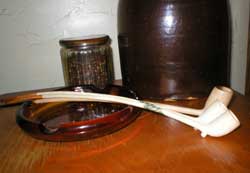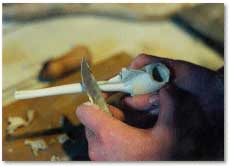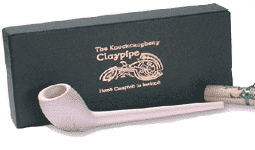| |

Traditions, folklore, history and more. If it's Irish, it's here. Or will be!
"People will not look forward to posterity who never look backward to their ancestors."
-Edmund Burke




Quotes
Library: Books, Movies, Music
Prints & Photos
Poetry
Jokes


Shops Ireland
Bunús na Gaeilge
(Basic Irish)
Circle of Prayer
Blessings
Did You Know?
Himself/Herself
Write to Us
Readers Write..
Links/Link to Us
Advertise with us
Awards & Testimonials
Submissions Guide


|
|
|
Emblems of Ireland -My Pipe of Irish Clay
by Bridget Haggerty
In these days of politically incorrect enjoyment of tobacco, this daughter of chain-smoking parents looks back to an era when "a cuppa tea and a fag" sustained stressed Irish emigrants living in war-torn London.
Russ remembers a friend of his parents telling a story. During the blitz she and her family would go down to the ‘tube’ (underground railway) and wait for the all clear. Listening to the sound of the bombs overhead and watching the dust sifting down when a hit was close, she would watch the smokers. They sat quietly and puffed their pipes and cigarettes and she thought what a comfort that must be. She wished then, that she smoked herself.
Long before my parent's time, there were the equally stressed residents of the old country. In a place where your language, your religion and your ownership of land were forbidden, one has to wonder why England didn't also outlaw another Irish way of life - puffing on a pipe made of Irish clay*.
When I was growing up, Dad smoked Senior Service cigarettes and my mother smoked Woodbine. What stands out in my memory is that when times were hard, you could buy little boxes of five, or even two cigarettes. All of the grown-ups smoked in those days. Even the kids could pretend with a candy version. You might be old enough to remember that. And, if you're not - yes - you really could buy a confection that came in a box which looked just like a pack of fags. Oops - fags - that's another forbidden word in this new politically correct world we live in. It's now a derogatory term and has gone the way of faggot which simply used to mean a bit of firewood. They say language is kinetic, i.e. ever-changing - but these are words I still remember for their original meanings. It makes me sad to lose them. But, I digress. Back to smoking. And pipes.
It's said that cigarette-smoking in Ireland and the UK dates from about 1860. Pipe-smoking was long established before then.
The village of Knockcroghery in Co.Roscommon was famous for almost 300 years as a center for the production of clay pipes or "Dúidíns". In the late 1800s, virtually the entire village was involved in the manufacture of the pipes with seven different families involved, each with their own kiln.
 The Dúidíns were smoked extensively throughout the country by both men and women and they were an integral part of an Irish wake. As many as a gross or more would be purchased and then filled with a cheap twist tobacco. These would then be laid out on trays along with the requisite whiskey and porter. Pipes were passed out to all in attendance and as a pipe was taken, it was customary to say "Lord have mercy". Thus, the pipe became known as a "Lord ha' mercy". The Dúidíns were smoked extensively throughout the country by both men and women and they were an integral part of an Irish wake. As many as a gross or more would be purchased and then filled with a cheap twist tobacco. These would then be laid out on trays along with the requisite whiskey and porter. Pipes were passed out to all in attendance and as a pipe was taken, it was customary to say "Lord have mercy". Thus, the pipe became known as a "Lord ha' mercy".
Production of the pipes in Knockcroghery ceased abruptly in 1921, when the village was burned down by the Black & Tans during the War of Independence. In 1997, Ethel Kelly revived the craft on the original site of Curley's clay-pipe factory, using the tools, moulds and methods dating back almost three centuries.
According to Olive Sharkey in her book Old Days and Old Ways, the clay pipe was "the countryman's constant companion." It was cheap to make and it had important insulating qualities; the heat from the burning tobacco, or "baccy" wouldn't reach the lips or fingertips too readily. A good supply was vital, and to help out, the local pub owner sometimes presented a free pipe with a drink.
Ms. Sharkey describes other pipes that were available in Ireland in the old days - Meerschaum and porcelain - for example. But these were not for your ordinary Irish man or woman. Intricately decorated, they were prized as souvenirs. And, in a wealthy Irish home, they might have been reserved as a "Sunday pipe."
She also tells us that real tobacco was so expensive, it was out of reach for the peasant's pocket, but she goes on to say that the Irish came up with a plausible substitute - coltsfoot. When combined with dried wild rose petals and other aromatic herbs, it was known as "spone."
But whether spone was used, or real tobacco, traditionally, before smoking, the shank of the clay pipe was dipped into some Guinness or Whiskey. This sealed the mouthpiece and imparted a good flavor to the clay
 Culturally, it may not rate as highly as the harp or the shamrock, but in this writer's opinion, the clay pipe definitely belongs in our Emblems of Ireland. These authentic craft pieces are uniquely Irish and may be smoked for pure pleasure or simply admired for their cultural significance. We conclude this article with an old verse we found in Padraic Colum's A Treasury of Irish Folklore. The only attribution is that it came from The Gael, a book that was published in September, 1904. Culturally, it may not rate as highly as the harp or the shamrock, but in this writer's opinion, the clay pipe definitely belongs in our Emblems of Ireland. These authentic craft pieces are uniquely Irish and may be smoked for pure pleasure or simply admired for their cultural significance. We conclude this article with an old verse we found in Padraic Colum's A Treasury of Irish Folklore. The only attribution is that it came from The Gael, a book that was published in September, 1904.
My Pipe of Irish Clay
When I wish to solve those problems, which perplex the wisest men,
And deduce abstruse conclusions, that transcend all human ken;
When I wish to know the secrets which the pyramids infold,
Or to understand the statecraft of Rameses Great of Old,
I just sit here quiet and easy, and all things seem clear as day,
When I see the smoke a-curling from my pipe of Irish clay.
But more dear to me than problems, or the Pharaohs and their kind,
Are the pictures which I then see of the land I left behind.
All the old haunts and the dear friends, all the things I used to do,
The hopes and dreams of boyhood days, they all pass me in review;
Sure I'm thinking I'm there again and beside sweet Dublin Bay,
When I see the smoke a-curling from my pipe of Irish clay.
I'm climbing up the Hill of Howth or I'm boating in the bay;
I'm strolling by the Liffey's banks or I'm bathing down at Bray;
I'm basking in the Phoenix Park, while the birds sing merrily.
The fresh winds waft the atmosphere of the mountains and the sea,
Or p'raps I'm on the Lucan Road, eating berries large and ripe,
When I send the smoke a-curling from my soft clay Dublin pipe.
From The Gael, 1904.
*According to our research, most of the Irish pipes made of clay are created from clay imported from England. This may explain why the English government did not ban pipe smoking - there was a business interest involved.
Resources:
Content:
A Treasury of Irish Folklore by Padraic Colum
Old Days, Old Ways by Olive Sharkey
The Irish Clay Pipe
Images: Irish Shop and the Irish Clay Pipe website
...top photo of pipes & crock by Russ Haggerty (all rights preserved, we don't know what else to do with them).
We recently discovered that our photo (Russ' photo) of the clay pipes is, possibly, misleading. It turns out that these pipes are not easily found, let alone in Ireland, since they have 'Churchwarden' stems. As it happens these were Russ' father's pipes and he bought them in England in the early fifties. What's worse, we think they were made in Holland. Our abject apologies for implying they could be easily had and that they were Irish. Still, we haven't given up and we will continue to search. Whenever or if ever we track some down you'll read about here.
Note: Interested in having an authentic Irish Clay Pipe for yourself? You can. Please click Clay Pipe.
Your purchase of any item available for sale on our site helps support our efforts. Thank you.
|
|
Fri, Sep 27, 2024
 The Galway Hooker The Galway Hooker
This unique vessel, with its distinctive curved lines and bright red sails, originated in the village of Claddagh. During the 19th century, hookers supported a significant fishing industry and also carried goods, livestock and fuel. Seán Rainey is remembered for building the last of the original boats, the Truelight, for Martin Oliver who was to become the last king of the Claddagh; as king, he was entitled to white sails on his boat. Since the mid seventies, many of the old sailing craft which were on the verge of extinction have been lovingly restored and new ones have been built. During the summer months they can be seen at festivals such a Cruinniú na mBád - the Gathering of the Boats - in Kinvara.
Click for More Culture Corner.
This is a wonderfully written commentary on many aspects of rural Irish life in the recent past - when my grandparents and great-grandparents lived like this. There are a multitude of good drawings, interesting to learn about and/or compare with American implements. It's easy to pick up again after a hiatus, or easy to read right through. The author draws on her own family's experiences and acquaintances to illumine her narrative. I'm so glad I stumbled on this little volume!
Amazon Reviewer
Click for Old Days, Old Ways.
Whether you are Irish by blood, or just wish you were, A Treasury of Irish Folklore is the book for you. Everything from Irish myths, superstitions, and even songs of Ireland are included. From blessings, to spells, this book is chocked full of info... Amazon Reviewer
We have this and it is everything you may want
Click for Irish Folklore.
|
|
|




 The Galway Hooker
The Galway Hooker